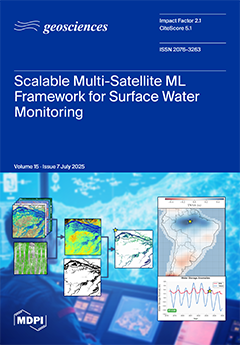Simulating potential glacier collapses can provide crucial support for local disaster prevention and mitigation efforts. The Xiaomagou Glacier in the Amnye Machen Mountains, Qinghai–Tibetan Plateau, has experienced five collapses in the past two decades. Field investigation and remote sensing observations indicate that the
[...] Read more.
Simulating potential glacier collapses can provide crucial support for local disaster prevention and mitigation efforts. The Xiaomagou Glacier in the Amnye Machen Mountains, Qinghai–Tibetan Plateau, has experienced five collapses in the past two decades. Field investigation and remote sensing observations indicate that the topography and bedrock characteristics of the Qushi’an No. 22 Glacier, which is 3.5 km south of the Xiaomagou Glacier, are similar to those of the Xiaomagou Glacier. More importantly, the mass movement of the Qushi’an No. 22 Glacier since 2018 closely resembles that of the Xiaomagou Glacier exhibited before its previous collapses. Therefore, in the context of rising temperatures, it is possible that the Qushi’an No. 22 Glacier will collapse in the near future. Based on remote sensing imagery and the glacier’s surface elevation changes, we reconstructed the 2004 collapse process of the Xiaomagou Glacier via numerical simulation. The key parameters of the mass flow model were optimized based on the actual deposition area of the 2004 collapse. The model with optimized parameters was then used to simulate the potential Qushi’an No. 22 Glacier collapse. Two collapse scenarios were set for the Qushi’an No. 22 Glacier. In Scenario 1, the lower half of the tongue detaches; in Scenario 2, the whole tongue detaches. Simulation results show that, in Scenario 1, the maximum mass flow depth is 72 m, the maximum mass flow speed is 51.6 m/s, and the deposition area is 5.40 × 10
6 km
2; in Scenario 2, the maximum mass flow depth is 75 m, the maximum mass flow speed is 59.7 m/s, and the deposition area is 6.32 × 10
6 km
2. In both scenarios, the deposition area is much larger than that of the Xiaomagou Glacier 2004 collapse, which had a deposition area of 2.21 × 10
6 km
2. The simulation results suggest that the Qushi’an No. 22 Glacier collapse could devastate the pastures and township roads lying in front of the glacier, seriously affecting local transportation and livestock farming; furthermore, it may deposit in the Qinglong River, forming a large, dammed lake. At present, the Qushi’an No. 22 Glacier remains in an unstable state. It is crucial to strengthen monitoring of its surface morphology, flow speed, and elevation.
Full article





